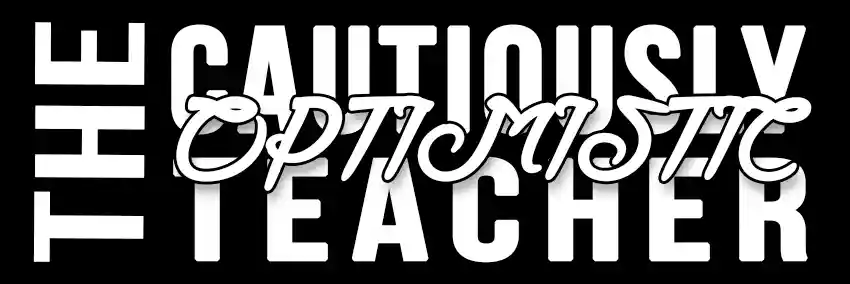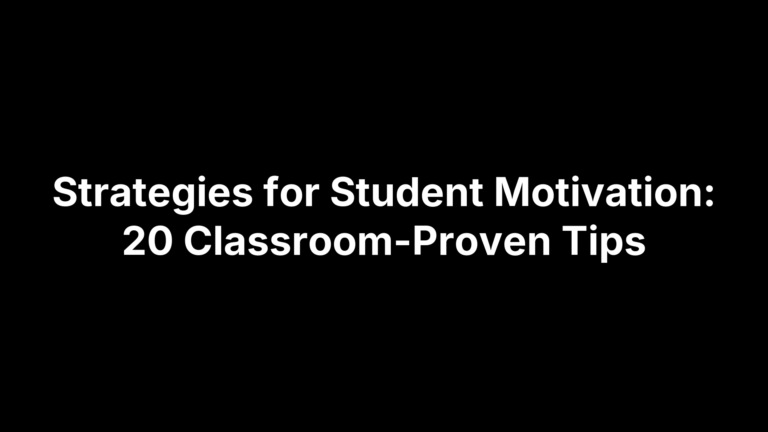20 Differentiated Instruction Strategies for Math Classrooms
Below you’ll find 20 classroom-tested ways to adapt math instruction so every learner can thrive.
Differentiated instruction means fine-tuning content, learning processes, products, and even seating so varied ability levels, interests, and IEP needs all receive the right stretch or support.
It’s a practical answer to those evenings you spend retyping worksheets, redrawing number lines, and rewriting directions just to meet each student where they are.
That’s crucial when a unit test looms, the pacing guide marches on, and you’re juggling early finishers with classmates still battling the warm-up.
The good news: purposeful tweaks—big or small—can reclaim class minutes, lift confidence, and keep the whole group moving forward together.
That’s exactly what this list is built to help you do.
Grab your planner and jump in; the first tip is a surprisingly powerful AI helper you may not know exists.
1. Leverage an AI-Powered Differentiated Instruction Helper (The Cautiously Optimistic Teacher)
Start differentiation in seconds by letting the platform’s AI turn one lesson aim into multiple leveled resources. Instead of spending prep blocks rewriting tasks, you paste your objective, click a few options, and receive ready-to-print materials that meet every math learner where they are.
Why This Strategy Saves You Hours
- Generates tiered practice, projects, and games in under a minute
- Aligns each output to readiness, modality, and common IEP/504 accommodations
- Lets you tweak any prompt, so teacher judgment—not the algorithm—has final say
Step-by-Step Setup Guide
- Enter the standard or “I can” statement (
7.EE.3—solve multi-step problems using rational numbers). - Select difficulty tiers (emerging, on-level, extension).
- Choose formats: problem set, card sort, or enrichment project.
- Toggle scaffolds—visuals, sentence starters, hint buttons.
- Click “Generate” and download the differentiated packet.
Classroom Example
For a Grade 7 ratio lesson, the Helper produced:
- 12 practice problems split into three color-coded levels
- A hands-on card sort matching
part:wholepictures to fractions - An optional Scratch coding challenge that models equivalent ratios
That’s differentiated instruction for math—delivered in minutes, not periods.
2. Design Tiered Assignments Around Core Standards
Tiered assignments keep everyone working toward the same standard while allowing different entry points and challenge levels—a cornerstone of differentiated instruction for math. With one prep, you meet strugglers, on-level learners, and high fliers without watering anything down.
Planning the “High-Low-Middle” Continuum
- Pinpoint the non-negotiable concept (e.g., multiplying fractions).
- Draft three versions that vary in complexity, support, and cognitive demand.
- Check all tiers against the same success criteria to maintain rigor.
Managing Logistics Without Publicly Labeling Students
Handouts get a discreet color dot or symbol; only you know what it means. Pass them out face-down, rotate colors each unit, and students avoid any tier stigma.
Sample Tier Breakdown Table
| Tier | Focus & Supports | Sample Task |
|---|---|---|
| 1 | Concrete visuals, guided steps | Shade 3/4 × 1/2 on fraction bars and write the product |
| 2 | Algorithm + word problems | Solve 5/6 × 3/4 in a recipe context; explain reasoning |
| 3 | Real-world application, error analysis | Analyze a peer’s skateboard budget multiplying mixed numbers; correct mistakes |
3. Create Rotating Math Learning Stations
Rotating stations let you work with targeted groups while classmates tackle purposeful tasks, making differentiated instruction for math manageable in any size room. Students cycle through two to four stations per class, depending on lesson goals.
Station Types That Work in Any Grade
- Fluency Sprint: rapid facts, mental math
- Concept Lab: manipulatives or model exploration
- Teacher Table: data-driven mini-lesson
- Tech Hub: adaptive practice app
Timers and Transition Tips
Run 12-15-minute blocks; project a countdown, play a chime, and task one captain with cleanup.
Station Setup Checklist
- Pod desks; tape arrows for traffic
- Stock labeled bins
- Provide recording sheets or Google Form
- Post one reflection prompt
4. Implement Flexible Grouping That Changes With the Data
Even the best-planned lesson can stall if yesterday’s groups no longer match today’s understanding. Fluid, needs-based grouping keeps differentiated instruction for math nimble, ensuring every learner gets just-right support or stretch—without branding anyone as “advanced” or “behind.”
Moving Beyond Static “Bluebirds and Robins”
Ditch the permanent reading-group mindset. Form teams around a single goal—say, estimating square roots or setting up proportion equations—and dissolve them once the goal is met. Rotate every week or two so students experience new collaborators and roles.
Data Sources for Regrouping
- Quick pre-unit quizzes
- Daily exit tickets color-coded red/yellow/green
- Observation notes in a digital clipboard
- Real-time dashboards from adaptive apps
These micro-assessments tell you who needs reteach, guided practice, or enrichment—no guesswork required.
Norms for Respectful Movement
Model language like “We’re regrouping so everyone gets what they need today.” Post a schedule, use neutral team names (Shapes, Planets), and teach a 30-second desk shuffle routine. Students learn that movement signals growth, not ranking.
5. Differentiate Through High-Impact Questioning Techniques
Varying the cognitive load of your prompts instantly personalizes discussion; every learner finds an entry point, nobody coasts.
Using Bloom’s and Depth of Knowledge (DOK) Levels
Prewrite questions at four levels: recall (define prime), skill (factor 42), strategic (compare two ways to multiply 12×15), extended (prove why primes > 3 aren’t multiples of 2 or 3).
Socratic Seminars in Math
Hold monthly Socratic circles around a juicy problem or data set. Students probe one another; you chart misconceptions and toss extension questions to advanced groups.
Sample Question Ladder
-3 + 7 = ?(recall)- Why does the sum’s sign turn positive? (skill)
- Invent a real-life context for
-3 + 7. (strategic) - Generalize a rule for adding oppositely signed numbers. (extended)
6. Offer Choice Boards and Learning Menus
When students steer some of their own practice, engagement spikes and grading piles shrink—two wins for differentiated instruction for math. Choice boards and learning menus hand over limited autonomy while still pointing everyone toward the same standard.
Structuring a 3×3 Tic-Tac-Toe Board
- Columns move from concrete to abstract; rows move from low-floor to high-ceiling tasks.
- Example headings: Practice It · Create It · Teach It.
- Students complete three in a row, but can aim for a blackout if time allows.
Balancing Must-Dos vs. Can-Dos
- Star one “non-negotiable” square per row—essential skill practice.
- Remaining squares become enrichment or reteach options.
- Post time estimates so pacing doesn’t derail ambitious choosers.
Rubric Aligned to Choices
| Criterion | 4 | 3 | 2 | 1 |
|---|---|---|---|---|
| Math Accuracy | All work correct | Minor error | Multiple errors | Major misconception |
| Reasoning/Explanation | Clear, detailed | Adequate | Limited | Absent |
| Presentation | Creative & organized | Neat | Incomplete | Disorganized |
One rubric covers any product—poster, screencast, or written solution—making scoring fast and fair.
7. Incorporate Math Task Cards for On-Demand Practice
Mini, movable, and infinitely mix-and-match, math task cards give you a grab-and-go way to serve just-right practice without photocopy overload. Students pull a single card—or a whole stack—based on current needs, so differentiation happens organically during work time or stations.
Why Task Cards Beat Worksheets
- Pocket-sized prompts feel less overwhelming than a full sheet
- Easy to color-code levels or add QR-code hints for scaffolding
- Self-checking backs let fast finishers monitor accuracy without teacher wait time
Four Ways to Use Them
- Scoot: students rotate desks, solving a new card every minute
- Scavenger Hunt: hide cards around the room for kinesthetic review
- Exit Choice: pick any two cards to complete before packing up
- Early Finisher Bin: ongoing challenge deck sorted by strand
DIY Task Card Creation Tips
- Print 4×6 cards; laminate for dry-erase reuse
- Number each card and provide a recording sheet for accountability
- Vary representations—diagram, word problem, equation—to reach diverse thinkers
8. Integrate Real-World Problem Scenarios and Projects
Projects tied to real numbers and decisions students make every day help abstract skills feel useful and invite multiple entry points for differentiated instruction for math.
Connecting Standards to Authentic Contexts
Turn 6.NS.3 into planning a field-trip budget or map F-IF.4 onto tracking TikTok follower growth; the context provides built-in meaning and cross-links to literacy.
Differentiating Roles Within the Project
Let teams self-select as Analyst, Designer, or Presenter. Roles vary in math intensity and communication style, so each student contributes from a position of strength.
Assessment With Choice of Product
Grade products with a single rubric focused on accuracy and reasoning. Students may submit a screencast, infographic, or written brief—diverse outputs, consistent expectations.
9. Scaffold Learning With the Concrete-Representational-Abstract (CRA) Model
CRA moves learners from hands-on objects to pictures to symbols, giving everyone a clear ramp to abstraction—differentiated instruction for math at its simplest.
Stages Explained
Concrete: manipulatives. Representational: sketches/models. Abstract: numerals or variables. Progression cements meaning before students tackle pure algorithms.
Matching Students to Entry Points
Quick pre-checks sort kids: keep blocks until 85 % accuracy, switch to drawings, then graduate to symbols.
Classroom Example: Intro to Algebraic Expressions
Balance scales introduce variables: washers represent x, cubes constants. Students model 2x + 3 = 9, sketch it, then solve algebraically to show x = 3—three passes, one concept.
10. Use Daily Formative Assessments and Exit Tickets
Tiny, targeted check-ins let you steer tomorrow’s lesson before today’s pencils hit the tray. A two-item exit ticket or one-question digital poll quickly exposes misconceptions, confirms mastery, and gives you concrete data for regrouping—making differentiated instruction for math a living, breathing routine instead of a once-a-unit event.
Crafting High-Yield Prompts
- One standards-aligned problem that mirrors the day’s focus (
8.EE.7b — solve linear equations with rational coefficients). - A metacognitive cue: “What step felt tricky and how did you overcome it?”
- Optional stretch: invite advanced learners to write an error analysis version of the problem.
Sorting Data in Under 5 Minutes
- Traffic-light stickies: students post green, yellow, or red on the door as they leave.
- Spreadsheet or Google Form set to conditional color-coding for instant visual trends.
- Snap a photo of completed tickets for later review; recycle the paper.
Immediate Next-Day Adjustments
Reteach red-light students in a five-minute warm-up huddle, assign yellow-lights a guided practice station, and release green-lights to an enrichment problem set or peer-coaching role. Everybody moves forward from exactly where they stand—no guessing required.
11. Apply Curriculum Compacting for Advanced Learners
Curriculum compacting releases students who have already mastered today’s objective from repetitive practice and channels their energy into richer challenges. It’s a cornerstone move when differentiating instruction for math with mixed-ability classes.
Identifying Mastery Quickly
A five-question pre-test or adaptive quiz shows mastery; anyone hitting 80 % or higher earns the right to compact. Log scores so families see mastery was demonstrated, not presumed.
Replacement Activities
Offer a choice of independent inquiry, peer tutoring, or an online acceleration path aligned to upcoming standards. Give them a rubric up front to keep expectations transparent.
Monitoring Accountability
Set up a simple contract with checkpoints and mini-conferences so products stay rigorous and deadlines don’t drift.
12. Embed Adaptive Technology Apps and Games
Adaptive software transforms each click into real-time data you can use to fine-tune differentiated instruction for math. The right app quietly levels questions up or down so no student ever faces work that’s too easy or impossibly hard.
Features to Look For
- Auto-diagnostics that recalibrate difficulty in fewer than five items
- Immediate, explanatory feedback students can replay on demand
- Teacher dashboard with exportable progress and skills reports
Classroom Management of Screen Time
Limit use to a 15-minute rotation or homework slot; post weekly mastery goals and keep a “need help” sign so you can conference while others play with headphones.
Suggested Free & Low-Cost Tools
Khan Academy missions, Prodigy Math, and the Quizziz adaptive practice mode each tick the feature boxes without busting the budget.
13. Facilitate Think-Pair-Share With Role Cards
Think-Pair-Share is quick, but quiet students can still hide. Role cards fix that: every partner gets a job, so talk time is shared and math reasoning surfaces. Learners first think alone, then pair with roles, and finally share concise findings class-wide.
Assigning Roles to Balance Participation
Hand pairs four colored cards—Thinker (explains), Questioner (pushes why), Recorder (captures process), Reporter (presents). Swap cards each new problem to build balanced discourse skills.
Question Prompts That Spark Deeper Reasoning
Use tiered prompts such as:
- Why does
a(b+c)equalab+ac? - Create a story for
-7 + 12.
Debriefing Strategies
Chart reporters’ answers, then have everyone quick-write one takeaway or lingering question.
14. Encourage Math Journals and Learning Logs
A low-tech notebook can be a high-impact differentiation tool. When students regularly write about their reasoning, misconceptions surface early, vocabulary sticks, and shy thinkers get a voice without raising a hand. Five minutes at the end of class is enough to build the habit.
Types of Entries
- Quick reflection: “What strategy worked for solving
12÷0.3?” - Error analysis: identify and correct a mistaken solution the teacher provides
- Vocabulary concept map: connect “coefficient” to examples, non-examples, and visuals
Differentiating Prompts
- Sentence starters for emerging writers: “One thing I still wonder about is … ”
- Choice of media for advanced writers: diagram, proof, or paragraph
- Optional challenge: “Generalize today’s rule for any real numbers
aandb.”
Feedback Without Overloading Yourself
- Colored stamp code: green = on track, yellow = revise, red = conference
- Peer-review checklist traded once a week
- 20-second audio comments recorded in Google Classroom for targeted coaching
15. Run Small-Group Guided Math Sessions
Guided math seats 4–6 learners at the kidney table for laser-focused coaching while their classmates tackle stations or independent work. Because you target exactly what each mini-group needs in the moment, it’s one of the quickest, most effective ways to deliver differentiated instruction for math—nobody idles, everyone advances.
Scheduling Within a 60-Minute Period
Open with a 10-minute warm-up, rotate through three 15-minute groups, and close with a 5-minute reflection or exit slip.
Grouping Based on Specific Skill Gaps
Sort students using yesterday’s exit-ticket data: fractions fix-ups, place-value precision, or algebra extension—groups dissolve once the gap closes.
Mini-Lesson Template
Hook problem → teacher think-aloud → guided practice → independent try → 60-second dry-erase check. Release students back to stations armed with fresh confidence.
16. Provide Multiple Representation Opportunities
Showing math in several formats—visual, numeric, algebraic, and verbal—gives every student an on-ramp that matches their learning style and a bridge to the next level. Swapping among views during a single lesson makes abstract ideas sticky and keeps the whole class engaged.
The “Rule of Four”
- Visual: graphs, diagrams, manipulatives
- Numeric: tables of values or data sets
- Algebraic: equations, formulas (
y = ax² + bx + c) - Verbal: written or spoken explanations
Tools and Materials
- Mini whiteboards and graph paper
- Virtual manipulatives (Desmos, GeoGebra)
- Color-coded graphic organizers
- Sentence-stem cards for oral summaries
Sample Activity: Quadratic Functions
Students explore projectile motion by:
- Plotting height vs. time data (numeric → visual).
- Fitting a curve on Desmos (visual → algebraic).
- Writing a real-world story of the path (verbal).
Groups present all four views, proving thath(t) = -16t² + vt + smodels the jump.
17. Offer Self-Paced Learning Paths and Progress Checklists
Some students race ahead while others still wrestle with yesterday’s concept—self-paced paths let both groups win without fracturing the class community. By mapping objectives to bite-size checkpoints and handing learners a clear checklist, you turn pacing over to them yet keep visibility over who needs a nudge. It’s differentiated instruction for math that runs quietly in the background while you coach where you’re most needed.
Creating a Unit Roadmap
Chunk the unit into sequenced “stops”: objective, mini-lesson video, practice set, and quick quiz. Post the roadmap in Google Classroom and print a one-page tracker so students tick off each stop as they demonstrate 80 % mastery.
Managing Classroom Flow
Display a simple “conference traffic light”: green = available, yellow = checking work, red = mini-group. Students sign up digitally or drop a clothespin on your board, freeing you to target misconceptions while others advance independently with earbuds or peer buddies.
Celebrating Milestones
Every checkpoint unlocks a small reward—digital badge, sticker on a progress chart, or a two-minute class shout-out. Finishing the entire path early earns access to an enrichment mission, keeping high flyers challenged without extra grading for you.
18. Implement Peer Teaching and Math Buddies
Peer teaching flips students into the teacher’s seat for a few minutes, multiplying explanations, boosting reasoning, and freeing you for targeted conferences.
Pairing Strategies
- High-plus-middle pairing keeps help just challenging enough.
- Rotate buddies each unit to avoid labels.
- Match by shared interests to spark natural math talk.
Structured Tutoring Protocol
Give the coach a laminated cue card: Ask → Solve → Check → Praise. Learners verbalize thinking, then both compare solutions with an answer key for instant feedback.
Reflection to Solidify Learning
An exit slip—“One insight I gained from teaching today…”—locks the concept and supplies diagnostic evidence you can use tomorrow.
19. Build a Growth Mindset Culture With Regular Reflection
Differentiated instruction fizzles if students believe math ability is fixed. A steady diet of language, routines, and metacognition shows every learner that effort changes the brain—fueling perseverance when tasks get tough or tiered work looks different across desks.
Language Shifts
Swap “You’re so smart” for “Your strategy paid off” and tack the word yet onto “I can’t.” Post sentence stems like “My next step is…” so class talk defaults to progress, not talent.
Reflection Routines
Try “Favorite Mistake” Fridays, two-minute goal-setting slips on Mondays, or a mid-unit “What stretched me?” quick write. Short, scheduled check-ins normalize struggle and celebrate revision.
Linking Mindset to Differentiation
Explain that multiple pathways exist because brains learn at different paces; tiered tasks and regrouping are tools for growth, not labels. When students see choice as opportunity, they lean into challenges instead of opting out.
20. Differentiate Homework and Practice Assignments
The work students take home should reinforce learning, not amplify frustration or boredom. By layering tasks and letting learners self-select the right stretch, you extend differentiated instruction for math beyond the bell without doubling your grading load.
Choice and Challenge Levels
Assign a core set of five must-know problems for everyone, then attach two optional paths: a reteach sheet with worked examples and a brain-stretch challenge featuring multi-step or open-ended items. Students decide what they need after a quick self-check.
“Must-Do, Should-Do, Aspire-To” Framework
Label each task tier clearly on the handout and in your LMS. Families see the minimum expectation, suggested practice, and an aspirational bonus, so support at home matches classroom language.
Feedback Loop
Include QR codes that reveal step-by-step solutions, post common errors on a next-day anchor chart, and drop targeted comments on digital submissions. Fast, actionable feedback keeps the home practice cycle productive and self-correcting.
Pulling It All Together
Differentiated instruction for math isn’t a single tactic—it’s a mindset supported by smart structures. When you blend quick data checks, flexible grouping, and student voice with purposeful tools (yes, including a time-saving AI helper), every learner sees a clear path forward.
Remember the big three:
- Plan with the end in mind and pre-assess early.
- Offer varied entry points, processes, and products without lowering rigor.
- Nourish a growth mindset so students view differences as opportunities, not rankings.
Start small if you need to—one tiered assignment, one rotating station—then layer on tech, menus, and self-paced paths as routines solidify. Soon your classroom hums with students choosing challenges, reflecting on errors, and pushing past “I can’t” to “Watch me.”
Ready for more ready-made templates, AI tools, and weekly tips? Drop by The Cautiously Optimistic Teacher and grab the free newsletter.







